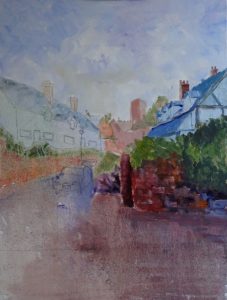For the past two weeks, I have been working on this scene in my weekly class to demonstrate one way of painting buildings. In the first demonstration, I washed in glazes, letting down the oil paints with copious amounts of “Zest-it”, as an underpainting for the buildings. You can see this thin paint on the left had side of the picture below. I have treated the sky and the distant church tower more immediately with thicker paint which should not need much modification later.
 The passage on the right hand side shows the beginning of the overpainting. Not a lot of the underpainting is left, but just enough shows to give depth to the painted surface. The main value to me is that the thinned paint uses the white canvas to create lighter tones, just as one does in watercolour. This in turn means that the true colour remains, not deadened by white paint, so I am encouraged to use true colour for the second pass – more vibrant and alive. I used yellow to lighten my greens, reserving a blued white for the cottages themselves. I am a bit cross that I didn’t make my underpainting of the cottages darker, for then I would not have needed to repaint the wooden beams. Next week I shall work on the white cottages on the left.
The passage on the right hand side shows the beginning of the overpainting. Not a lot of the underpainting is left, but just enough shows to give depth to the painted surface. The main value to me is that the thinned paint uses the white canvas to create lighter tones, just as one does in watercolour. This in turn means that the true colour remains, not deadened by white paint, so I am encouraged to use true colour for the second pass – more vibrant and alive. I used yellow to lighten my greens, reserving a blued white for the cottages themselves. I am a bit cross that I didn’t make my underpainting of the cottages darker, for then I would not have needed to repaint the wooden beams. Next week I shall work on the white cottages on the left.

One of the fascinating things to me with oil paint is that so many painters talk about how liberating it is to know that you can just paint over it if it’s wrong, and yet this layered underpainting technique creates fabulous effects, relying on not painting things out!